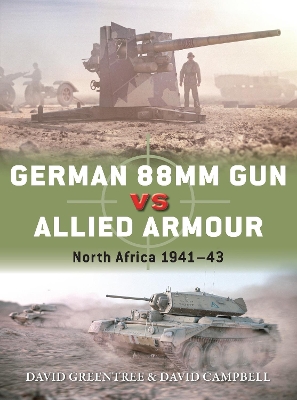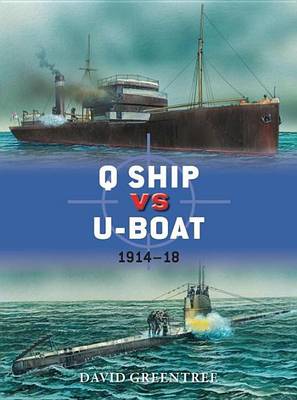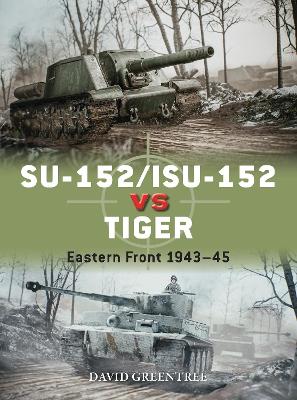Duel
5 total works
British Destroyer vs German Destroyer
by David Greentree and Mr David Campbell
Published 18 October 2018
The opening months of World War II saw Britain's Royal Navy facing a resurgent German navy, the Kriegsmarine. Following the German invasion of Denmark and Norway in early April 1940, British and German destroyers would clash in a series of battles for control of the Norwegian coast. The operational environment was especially challenging, with destroyer crews having to contend with variable weather, narrow coastal tracts and possibility of fog and ship breakdowns.
In two engagements at Narvik, the Royal Navy entered the harbour and attacked the loitering German destroyers who had dropped off mountain troops to support the German invasion. The raids were devastating, halving at a stroke the number at Hitler's disposal. Employing specially commissioned artwork and drawing upon a range of sources, this absorbing study traces the evolving technology and tactics employed by the British and German destroyer forces, and assesses the impact of the Narvik clashes on both sides' subsequent development and deployment of destroyers in a range of roles across the world's oceans.
In two engagements at Narvik, the Royal Navy entered the harbour and attacked the loitering German destroyers who had dropped off mountain troops to support the German invasion. The raids were devastating, halving at a stroke the number at Hitler's disposal. Employing specially commissioned artwork and drawing upon a range of sources, this absorbing study traces the evolving technology and tactics employed by the British and German destroyer forces, and assesses the impact of the Narvik clashes on both sides' subsequent development and deployment of destroyers in a range of roles across the world's oceans.
As the war in North Africa escalated, Axis war efforts became increasingly dependent on supply lines across the Mediterranean. To try to cut off these lines of supply the British deployed submarines from the besieged island of Malta with the directive to sink as much merchant convoy tonnage as possible. Italy responded by sending her Torpedo boats to protect and escort Axis convoys.
Featuring specially commissioned full-colour artwork and carefully chosen archive photographs, this engaging study assesses the evolving battle between Britain's submarines and Italy's torpedo boats in the struggle for primacy in the Mediterranean at the height of World War II.
Featuring specially commissioned full-colour artwork and carefully chosen archive photographs, this engaging study assesses the evolving battle between Britain's submarines and Italy's torpedo boats in the struggle for primacy in the Mediterranean at the height of World War II.
Few weapons developed a more deadly reputation than the German '88' in the role of anti-tank gun, its long reach and lethal hitting power making it a significant problem for every type of British and later American armour. Despite its individual potency, it was almost always utilized as part of a comprehensive system of defences that relied on a mix of weapons carefully deployed in anticipation of the enemy's likely avenue and method of attack. Used in this way, the 88 became a particularly deadly part of the Afrika Korps' attempts to shatter British armoured power in the Western Desert.
Initially extremely successful over the course of 1941 and 1942 in Operations Battleaxe and Crusader, the Allies' tactics and vehicles (such as the American-made M3 and the Crusader III) eventually evolved to deal with the 88's awesome power. This detailed new book tells the story of that evolution and provides an in-depth treatment of this key weapon of World War II.
Initially extremely successful over the course of 1941 and 1942 in Operations Battleaxe and Crusader, the Allies' tactics and vehicles (such as the American-made M3 and the Crusader III) eventually evolved to deal with the 88's awesome power. This detailed new book tells the story of that evolution and provides an in-depth treatment of this key weapon of World War II.
Q ships came in all shapes and sizes - coastal steamer, trawler, barque, yacht or schooner - but all had to look harmless in order to lure their opponents to the surface and encourage them to attack. Armaments differed according to ship size; steamers commonly had 4in guns mounted amidships and in the bow, trawlers 3-pdrs and sailing ships 12-pdrs. Those who served on Q ships had to accept that their U-boat opponents would be able to strike first. Q ship captains kept ready a 'panic crew', which was trained to act out an elaborate evacuation to convince the U-boat commander that the ship was being abandoned by its crew. The Q ship captain would remain behind with a handful of other crewmen manning the guns, which remained hidden until the most opportune time to unmask and engage the U-boat. The Q ship concept had emerged early in the war when no other method seemed likely to counter the U-boat threat, and flourished until new technologies and tactics were developed, tested and implemented.
This fully illustrated volume compares two of the most iconic AFV's: the SU-152/ISU-152 and the Tiger, used on the Eastern Front during World War II.
On the Eastern Front in 1943, the Tiger-equipped heavy Panzer battalions gave German armoured divisions an unmatched capability that cost the Red Army dearly. The Tiger's 88mm gun had the potential to carve through Soviet defences in the attack and cause havoc amongst advancing Soviet armoured formations when used in defence. Neither of the Red Army's heavy tanks (the KV-1 and KV-2) could match the Tiger's gun, and, more importantly, penetrate its armour at anything approaching standard combat range. The Soviet response was a stopgap Tiger-killing vehicle that mounted a 152mm artillery piece onto the KV tank's chassis: the SU-152. The latter would evolve into the ISU-152 in late 1943 (mounting the same powerful gun on an IS chassis). This fascinating book describes the mighty duels fought between these opposing AFVs. The colour illustrations explore key details of both the SU-152/ISU-152 and Eastern Front Tigers, including armament, ammunition and crew positions, and the period photographs show rarely seen views of these iconic AFVs in action. How each attempted to best the other using its strengths and advantages is documented across a wide range of dramatic Eastern Front armoured battles.
On the Eastern Front in 1943, the Tiger-equipped heavy Panzer battalions gave German armoured divisions an unmatched capability that cost the Red Army dearly. The Tiger's 88mm gun had the potential to carve through Soviet defences in the attack and cause havoc amongst advancing Soviet armoured formations when used in defence. Neither of the Red Army's heavy tanks (the KV-1 and KV-2) could match the Tiger's gun, and, more importantly, penetrate its armour at anything approaching standard combat range. The Soviet response was a stopgap Tiger-killing vehicle that mounted a 152mm artillery piece onto the KV tank's chassis: the SU-152. The latter would evolve into the ISU-152 in late 1943 (mounting the same powerful gun on an IS chassis). This fascinating book describes the mighty duels fought between these opposing AFVs. The colour illustrations explore key details of both the SU-152/ISU-152 and Eastern Front Tigers, including armament, ammunition and crew positions, and the period photographs show rarely seen views of these iconic AFVs in action. How each attempted to best the other using its strengths and advantages is documented across a wide range of dramatic Eastern Front armoured battles.




